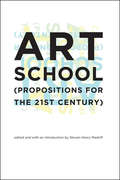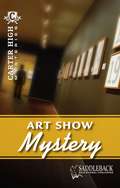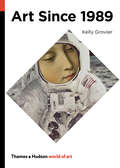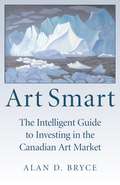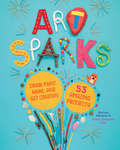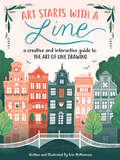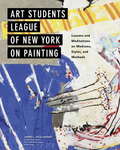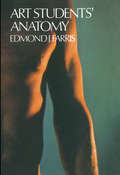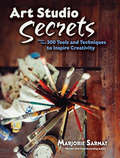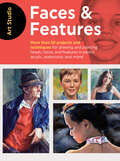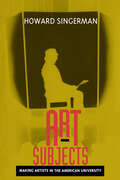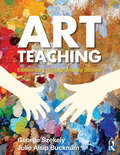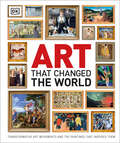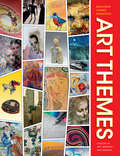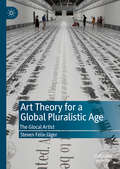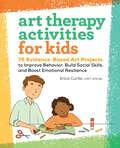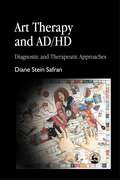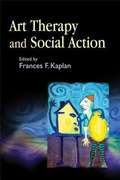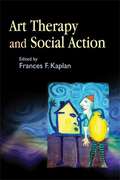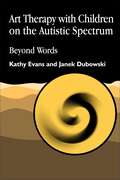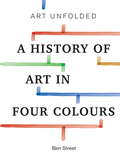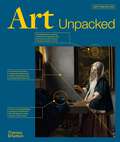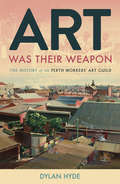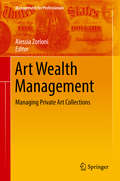- Table View
- List View
Art School: Propositions for the 21st Century
by Steven Henry MadoffLeading international artists and art educators consider the challenges of art education in today's dramatically changed art world. The last explosive change in art education came nearly a century ago, when the German Bauhaus was formed. Today, dramatic changes in the art world—its increasing professionalization, the pervasive power of the art market, and fundamental shifts in art-making itself in our post-Duchampian era—combined with a revolution in information technology, raise fundamental questions about the education of today's artists. Art School (Propositions for the 21st Century) brings together more than thirty leading international artists and art educators to reconsider the practices of art education in academic, practical, ethical, and philosophical terms. The essays in the book range over continents, histories, traditions, experiments, and fantasies of education. Accompanying the essays are conversations with such prominent artist/educators as John Baldessari, Michael Craig-Martin, Hans Haacke, and Marina Abramovic, as well as questionnaire responses from a dozen important artists—among them Mike Kelley, Ann Hamilton, Guillermo Kuitca, and Shirin Neshat—about their own experiences as students. A fascinating analysis of the architecture of major historical art schools throughout the world looks at the relationship of the principles of their designs to the principles of the pedagogy practiced within their halls. And throughout the volume, attention is paid to new initiatives and proposals about what an art school can and should be in the twenty-first century—and what it shouldn't be. No other book on the subject covers more of the questions concerning art education today or offers more insight into the pressures, challenges, risks, and opportunities for artists and art educators in the years ahead.ContributorsMarina Abramovic, Dennis Adams, John Baldessari, Ute Meta Bauer, Daniel Birnbaum, Saskia Bos, Tania Bruguera, Luis Camnitzer, Michael Craig-Martin, Thierry de Duve, Clémentine Deliss, Charles Esche, Liam Gillick, Boris Groys, Hans Haacke, Ann Lauterbach, Ken Lum, Steven Henry Madoff, Brendan D. Moran, Ernesto Pujol, Raqs Media Collective, Charles Renfro, Jeffrey T. Schnapp, Michael Shanks, Robert Storr, Anton Vidokle
Art Show Mystery (Walker High Mystery #1)
by Eleanor RobinsPaige wants to enter her painting in the art show, but thinks someone has stolen it. It isn't where she thinks she put it.
Art Since 1989 (World of Art)
by Kelly GrovierAn extensive, accessible guide to the most groundbreaking and influential art from 1989 to the present The years since the collapse of the Berlin Wall in November 1989 have seen the rise of a new freedom to define art—Who makes it? Where can it be found? What is its commercial value?—and, consequently, the reevaluation of art’s place in society. Kelly Grovier surveys the dynamic developments in art practice worldwide since 1989, focusing on artists whose fresh visual vocabulary and innovation reflect these past turbulent decades. The book’s ten chapters examine the key themes in contemporary art—portraiture in the age of face transplants and facial recognition software, political activism, science, and religion, to name a few—by artists including Jeff Koons, Louise Bourgeois, Damien Hirst, George Condo, Marlene Dumas, Sean Scully, Cindy Sherman, Banksy, Ai Weiwei, Antony Gormley, Christo and Jean-Claude, Jenny Holzer, Chuck Close, and Cornelia Parker. A chapter-length timeline at the end of the book traces the evolution of art from 1989 to today by closely examining one key artwork from each year. Illustrated with the work of over 200 key artists, Art Since 1989 is a lucid and engaging look at what may prove to be one of the more tempestuous eras in human history, if not the history of art.
Art Smart: The Intelligent Guide to Investing in the Canadian Art Market
by Alan D. BryceArt Smart is a comprehensive guide to the Canadian art market for both novice and experienced collectors. It is full of advice that can give anyone the tools to determine the value of a piece of art and to not be intimidated by the often mystifying world of art. This informative and helpful volume covers the inner workings of the art market, from dealer trade secrets to expert strategies on buying and selling through auction houses and online. Art Smart gives the reader the knowledge needed to build a collection for long-term investment value, and also covers tax and estate planning, copyright issues, and charitable donations. It also contains all the latest resources for art research, with useful appendices to guide the art consumer in becoming their own art connoisseur. Art Smart is essential reading if you are curious to know more about how the art market functions and is an excellent resource guide for those already involved.
Art Sparks: Draw, Paint, Make, and Get Creative with 53 Amazing Projects!
by Marion Abrams Hilary Emerson LayEvery kid can be an artist with this book as their guide! Using basic art supplies — from paint, markers, paper, and glue to household finds like cardboard boxes and fabric scraps — children aged 6 and up learn that as long as they can imagine it, they can create it. Curated by two art educators with decades of experience, this rich collection of 53 arts and crafts activities offers up a ton of freeform fun, from Doodlemonsters and Painted Animal Rocks to Paper Bead Jewelry and Nature Weaving. Projects vary in difficulty so there’s something for a wide range of ages and abilities, and many can be completed in under an hour. Each project featured in the book has been kid-made (and kid-approved!), and colorful photos of the finished pieces will ignite a creative spark that inspires budding makers to express their imagination, humor, and individuality through art. This publication conforms to the EPUB Accessibility specification at WCAG 2.0 Level AA.
Art Starts with a Line: A Creative and Interactive Guide to the Art of Line Drawing
by Erin McMannessEverything you need to master the art of line drawing, whether the goal is to draw for fun or illustrate an original masterpiece!Line drawing involves using a combination of fine lines and bold strokes to create artwork of any kind—from basic folk art to more sophisticated illustrations. This form of art requires minimal tools, making it both affordable and portable. In Art Starts with a Line, artists of all skill levels are invited to learn how to draw almost anything starting with simple lines and basic shapes.Following a brief introduction to tools and materials, as well as some easy exercises and techniques for warming up to basic drawing tools, you will explore a variety of subjects. You’ll draw plants and flowers, architecture and cityscapes, animals, and everything in between. These projects aren’t restricted to black and white either! You’ll find techniques for adding color with colored pencil, marker, pen, even digitally.Art Starts with a Line presents everything you’ll need to know to learn how to successfully create line drawings of all types. Whether your goal is to create a custom logo for a client, or to simply decorate your planner—it’s all here. Packed with engaging instruction, tips, and beautiful step-by-step artwork, this approachable, inspiring guide to line drawing shows beginning artists how to create meaningful artwork using simple lines and mindful prompts.
Art Students League of New York on Painting
by James L McelhinneyA lushly illustrated, comprehensive guide to painting in all media from the prestigious visual arts education institution Art Students League of New York.The Art Students League of New York is America's signature art school, run by artists for artists. Founded in 1875, it has nurtured students like Jackson Pollock and Georgia O'Keefe. Today, more than 2,500 students of all ages, backgrounds, and skill levels study there each month. This unique book brings you into the studio classrooms of some of the League's most celebrated painters--including William Scharf, Mary Beth McKenzie, Henry Finkelstein, and Knox Martin--for lessons on a variety of fundamental topics, idiosyncratic approaches, and quirky philosophies. Scanning the table of contents is like flipping through a course catalog: do you want to take Naomi Campbell's "Working Large in Watercolor," James McElhinney's "Journal Painting and Composition," Sharon Sprung's "Figure Painting from Life in Oil," or Ellen Eagle's "Poetic Realism in Pastel"? Now you can--from the comfort of your own home studio (or living room). Richly illustrated with artwork from the League's considerable archives, its instructors, and its students, this guide will inspire painters across all mediums, subjects, and styles.From the Hardcover edition.
Art Students' Anatomy
by Edmond J. FarrisA long-time favorite in art schools. Basic elements, common positions, and actions. Full text, 158 illustrations.
Art Studio Secrets: More Than 300 Tools and Techniques to Inspire Creativity (Dover Art Instruction)
by Marjorie SarnatAward-winning illustrator and painter Marjorie Sarnat presents an outstanding refresher course in creative thinking, suitable for artists of every level. In this guide, she shares the tips and techniques she's discovered in the course of her personal experiences and explorations. These 300 quick, easily grasped text passages detail methods for adding inspiration and innovation to your creative process. The new, hands-on approaches to materials, painting surfaces, and texture applications can help you find a fresh angle for your style or break through a creative block.Every "secret" in this book is expressed in practical terms geared toward boosting your artistic abilities. From sharpening your drawing skills and applying media in unique ways to creating intriguing visual illusions and refining your choices of color and composition, this guide is loaded with advice and fresh ideas. You'll also find cost-saving ways to obtain and manage your art tools and supplies as well as scores of ideas for making art with creative kids.
Art Studio: More than 50 Projects and Techniques for Drawing and Painting Heads, Faces, and Features in Pencil, Acrylic, Watercolor, and More!
by Walter Foster Creative TeamAn introduction for beginning artists and art enthusiasts to methods of drawing and painting heads, faces, and expressions using a variety of mediums. Drawing and painting heads, faces, and expressions can be an intimidating prospect for a beginning artist. Art Studio: Faces & Features is here to help, with more than fifty tips, techniques, and step-by-step projects that will have you creating expressive faces and mastering textures in all your drawings. This intuitive guide shows you how to work with graphite and colored pencils; acrylic, oil, and watercolor paints; pastels; and even pen and ink. This range of mediums is the perfect way to experiment, build artistic confidence, and define your own unique style. Art Studio: Faces & Features makes the art of drawing expressions possible for beginning fine artists. The Art Studio series is designed to help beginning artists venture into fine art; an overview of each art medium helps them determine which they like best.
Art Subjects: Making Artists in the American University
by Howard SingermanNearly every artist under the age of fifty in the United States today has a Master of Fine Arts degree. Howard Singerman's thoughtful study is the first to place that degree in its proper historical framework and ideological context. Arguing that where artists are trained makes a difference in the forms and meanings they produce, he shows how the university, with its disciplined organization of knowledge and demand for language, played a critical role in the production of modernism in the visual arts. Now it is shaping what we call postmodernism: like postmodernist art, the graduate university stresses theory and research over manual skills and traditional techniques of representation.Singerman, who holds an M.F.A. in sculpture as well as a Ph.D. in Visual and Cultural Studies, is interested in the question of the artist as a "professional" and what that word means for and about the fashioning of artists. He begins by examining the first campus-based art schools in the 1870s and goes on to consider the structuring role of women art educators and women students; the shift from the "fine arts" to the "visual arts"; the fundamental grammar of art laid down in the schoolroom; and the development of professional art training in the American university. Singerman's book reveals the ways we have conceived of art in the past hundred years and have institutionalized that conception as atelier activity, as craft, and finally as theory and performance.
Art Teaching: Elementary through Middle School
by George Szekely Julie Alsip BucknamArt Teaching speaks to a new generation of art teachers in a changing society and fresh art world. Comprehensive and up-to-date, it presents fundamental theories, principles, creative approaches, and resources for art teaching in elementary through middle-school. Key sections focus on how children make art, why they make art, the unique qualities of children’s art, and how artistic development can be encouraged in school and at home. Important aspects of curriculum development, integration, evaluation, art room management, and professional development are covered. A wide range of art media with sample art activities is included. Taking the reader to the heart of the classroom, this practical guide describes the realities, challenges, and joys of teaching art, discusses the art room as a zone for creativity, and illustrates how to navigate in a school setting in order to create rich art experiences for students. Many textbooks provide information; this book also provides inspiration. Future and practicing teachers are challenged to think about every aspect of art teaching and to begin formulating independent views and opinions.
Art That Changed the World: Transformative Art Movements and the Paintings That Inspired Them (DK Timelines)
by DKThis is your A to Z guide to art! From cave paintings to pop art and modern masterpieces, this absorbing and beautiful art encyclopedia explores the development of art in spectacular detail. Here&’s what you&’ll find inside the pages of this visually stunning art book: • Covers every major movement in art from prehistory to the present day • Each movement is tracked in a visual timeline that showcases its key paintings and notable artists, and explains its context — the major events in its evolution • Each section ends with a stunning image of a masterwork and a curator's analysis that encapsulates its values, style, composition and subject matter • Glossary of technical terms and a comprehensive index Get ready to embark on a unique guided tour throughout the history of art. Get to know more than 700 of the greatest artists, from Michelangelo and Monet to Damien Hirst and Picasso. Discover 2,500 of the world&’s most iconic paintings, sculptures and other artwork that has shaken the art world through centuries and across continents. Truly comprehensive in scope, Art That Changed the World presents the most remarkable art movements throughout history in chronological order and explains the social and cultural background of each period. Turning-point paintings that triggered or epitomised each artistic movement are identified and explained, against a backdrop of influences — from admired techniques of an earlier artist to the changes in society that enabled new directions in art. A must-have for your bookshelf, this is an indispensable art reference book for art-lovers everywhere!
Art Themes: Choices in Art Learning and Making
by Marjorie Cohee ManifoldFlexible in approach and full of colorful examples, this textbook provides a basic introduction to what art is and can be in the lives of people who do not necessarily think of themselves as "artists." You will be taught about a variety of art themes, genres, materials, and processes that appeal to novice art makers. The lessons are organized by themes of general subject matter or media. Options are available for work in mixed media, crafts, photography and digital media, as well as in traditional drawing or painting media. After picking a theme of particular interest to you, look next at the four strands of lessons presented in that thematic unit. Moving from left to right, select one lesson from each consecutive strand and complete that lesson. Because each lesson builds upon previously presented knowledge and developed skill, as you progress through four lessons, one from each strand, you should grow in your understanding of art concepts, meanings, and processes, while also improving your art making skills. Completing this course will help you develop a new appreciation for the power and possibilities of art learning, by understanding better the art others create, as well as making it yourself.
Art Theory for a Global Pluralistic Age: The Glocal Artist
by Steven Félix-JägerThis book extends a theory of art that addresses the present era’s shift towards global pluralism. By focusing on extrinsic rather than intrinsic qualities of art, this book helps viewers evaluate art across cultural boundaries. Art can be universally classified by an evaluation of its guiding narrative, and can be understood and judged through hermeneutical methods. Since artists engage culture through various local, transnational, and emerging global narratives, it is difficult to decipher what standards are used for evaluation, and which authoritative body evaluates the work. This book implements a narrative-hermeneutical approach to properly classify an artwork and establish its meaning and value.
Art Theory: A Very Short Introduction
by Cynthia A. FreelandIn today's art world, many strange, even shocking, things qualify as art. In this Very Short Introduction Cynthia Freeland explains why innovation and controversy are valued in the arts, weaving together philosophy and art theory with many fascinating examples. She discusses blood, beauty, culture, money, museums, sex, and politics, clarifying contemporary and historical accounts of the nature, function, and interpretation of the arts. Freeland also propels us into the future by surveying cutting-edge web sites, alongside the latest research on the brain's role in perceiving art. This clear, provocative book engages with the big debates surrounding our responses to art and is an invaluable introduction to anyone interested in thinking about art.
Art Therapy Activities for Kids: 75 Evidence-Based Art Projects to Improve Behavior, Build Social Skills, and Boost Emotional Resilience
by Erica Curtis LMFT, ATR-BCBuild social-emotional skills with art therapy activities for kids ages 6 to 9 Making art is a great way for kids to sort through their emotions and learn how to solve problems in creative ways. This standout choice among art therapy books for kids is filled with activities for you and your child, whether you're looking for a fun weekend activity with high social-emotional value or you need in-the-moment strategies for resolving conflict. Together, you'll learn how to harness the power of art to soothe worries, get organized, ease transitions, and much more! Lots of ways to get creative—Explore projects organized by artform: drawing and painting, building and sculpting, cutting and pasting, dancing and music making, and acting and storytelling. Art therapy activities made easy—Each activity includes a list of materials, step-by-step instructions, and helpful tips. Keep an eye out for discussion questions to inspire deeper conversations with your child! Simple materials—There's no need to buy fancy or expensive materials for these activities! You might even have most of them on hand, like paper, pens, construction paper, and a device to play music. Encourage good behavior and help your child thrive with Art Therapy Activities for Kids!
Art Therapy and AD/HD: Diagnostic and Therapeutic Approaches
by Diane SafranAttention Deficit/Hyperactivity Disorder is increasingly being diagnosed in people of all ages, and this book demonstrates how art therapy can not only assist with diagnosis, but also provides a valuable means of helping to improve skills such as concentration and focus, boost self-esteem, and cope with impulsivity. Educational social skills art groups can help with understanding of AD/HD in addition to teaching strategies to relieve the symptoms. Art therapy is also important for alleviating feelings of isolation and confusion that may come with the diagnosis, and, as an ongoing process, it can be a useful tool for checking clients' progress from the initial assessment onwards. In the first part of her book, the author explores ways of using art therapy and of setting up art therapy groups. Her advice and practical suggestions will be useful to anyone with an interest in AD/HD. The later chapters offer therapists more detailed guidance on therapy sessions with clients with AD/HD. Practical and informative, and based on the author's long experience with art therapy and AD/HD, this will be a valuable book for therapists, mental health professionals, and people who live or work with AD/HD.
Art Therapy and Social Action
by Michael Franklin Pat Allen Frances F. Kaplan Edward Ned Bear Susan Berkowitz Lani Alaine Gerity David GussakArt Therapy and Social Action is an exciting exploration of how professionals can incorporate the techniques and approaches of art therapy in their work to address social problems. Examining the expanding role of art practitioner as social activist, leading art therapists and other professionals show how creative methods can be used effectively to resolve conflicts, manage aggression, heal trauma and build communities. The contributors provide examples of innovative programs on a range of topics, including those designed to address gun crime, homelessness, racism and experiences of terrorism, among others. This timely book provides new techniques and successful models for art therapists, counselors and mental health practitioners working directly with the challenges of modern society.
Art Therapy and Social Action: Treating the World's Wounds
by Maxine Borowsky Junge Pat Allen Edward Ned Bear Susan Berkowitz Frances KaplanArt Therapy and Social Action is an exciting exploration of how professionals can incorporate the techniques and approaches of art therapy in their work to address social problems. Examining the expanding role of art practitioner as social activist, leading art therapists and other professionals show how creative methods can be used effectively to resolve conflicts, manage aggression, heal trauma and build communities. The contributors provide examples of innovative programs on a range of topics, including those designed to address gun crime, homelessness, racism and experiences of terrorism, among others. This timely book provides new techniques and successful models for art therapists, counselors and mental health practitioners working directly with the challenges of modern society.
Art Therapy with Children on the Autistic Spectrum: Beyond Words
by Janek Dubowski Kathy EvansRecent research has shown that art therapy can be particularly effective for children with autism and related communication disorders. The extensive range of symptoms experienced by autistic people makes them extremely individual in presentation, so any treatment used must be tailored to a range of varying needs. Art Therapy with Children on the Autistic Spectrum presents a new model of practice, which primarily focuses on communication difficulties. The authors describe how negative behaviours and subsequent tension may be alleviated when the autistic child is involved in interactive art making with the therapist. The book is divided into three parts: the first part explores art making processes and art work, with an emphasis on how art can be specifically communicative. A history of autism is presented within the therapeutic context. The second part challenges existing methods of practice within art therapy and considers the most appropriate approaches to treating autistic children. The last part discusses research that lead to the formulation of this specific model - methodology and assessment interventions are analysed, as well as the ongoing development of appropriate assessment instruments. Case studies of art therapy with individual autistic children demonstrate the use of the model and the outcomes. Throughout the book, it is emphasised how art therapy works as an integral part of overall management and treatment approaches to autism. It will be of particular interest to all those professionals working with autistic children and specialists in other communication disorders.
Art Unfolded: A History of Art in Four Colours
by Ben StreetDivine blueSensual redDeathly greenGlistening goldThese four colours tell the story of art in a way that few other elements can. From the pigments used to make them - sometimes wildly expensive, like ultramarine, or dangerously toxic, like emerald green - to the varied and changing meanings applied to them, these colours grant us access to fascinating stories, both of individual works of art and the world in which they were created.
Art Unpacked: 50 Works Of Art: Uncovered, Explored, Explained
by Matthew WilsonA down-to-earth, visual guidebook that shows how to “read,” understand, and get the most out of art. For beginners, art history might seem a daunting subject with complex rules and impenetrable technical language. Even for more seasoned art lovers the question of how to think about art is a perennial riddle. Art Uncovered is the perfect resource for both audiences: an engaging, visual primer for the general reader and educators. Designed like an instruction manual, fifty key artworks from around the world are deconstructed with explanations, diagrams, and close-ups in order to reveal the elements that comprise a masterpiece. Dating from the earliest times to the present, the artworks under analysis are drawn from many cultures and cover all forms of visual media, including drawing, illustration, photography, prints, and sculpture. Matthew Wilson’s simple approach, using established art historical methods, enables the reader to discover the fundamentals of art history, from considerations of function, historical context, iconography, and artists’ experience to broader issues of identity, including feminism, gender, and postcolonialism. Whether it’s the mask of Tutankhamun or Dorothea Lange’s photograph Migrant Mother, Katsushika Hokusai’s Great Wave or Kara Walker’s Gone, each image is dissected on the page in a no-nonsense style, with explanatory notes detailing artists’ sources of inspiration, associated styles and movements, plus any relevant quotes, related visuals, and other contextual and issue-led information with keywords for handy cross-referencing. The resulting book is a dynamic visual resource that will inspire and spark enjoyment of art in all its forms.
Art Was Their Weapon: The History of the Perth Workers' Art Guild
by Dylan HydeThe politics, art and culture of Perth's Workers Art Guildare detailed in this comprehensive history, as well as the personal andprofessional lives of some of the movement's key figures.The Workers' Art Guild was a left-leaning political force andinfluential cultural movement of the 1930s and 1940s in Perth. Policeand intelligence arms kept close tabs on the Guild and its members,jailing some and intimidating many others prior to and during theperiod of the banning of the Communist Party in Australia.The book covers the personal and professional lives of key figuressuch as writer Katharine Susannah Prichard and theatre maverickKeith George, while charting the influence of the Communist Party onWestern Australian artists.
Art Wealth Management: Managing Private Art Collections (Management for Professionals #0)
by Alessia ZorloniThis book offers an overview of how to manage private art collections, providing essential insights on art wealth management, art investment, art governance, and succession planning for art assets. It offers practical recommendations on sound art collection governance, but also examines the background of art markets and price building, including the influence of fashion and trends. Throughout history, art patronage has played an important role in the wealth of ultra-high-net-worth families and led to private museums funded by philanthropist collectors in order to celebrate their own tastes and leave a lasting legacy. Today, as a result of the growth of art investing by a new generation of wealthy collectors, not only artists but also wealthy families, sophisticated investors and their close advisors now face a more complex set of financial and managerial needs. As such, the contributions in this book will be of interest to collecting families, family offices, and professional advisors seeking to integrate art into their overall wealth management strategy, and to scholars in the fields of cultural economics, art dealers, curators, and art lovers.
